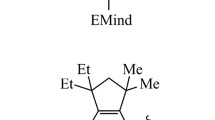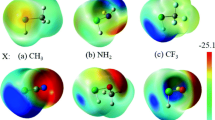Abstract
Ground and excited states of butadienes with silyl and alkyl substituents in 1/4-, 1/3-, 1/2- and 2/3-position, calculated by the Pariser-Parr-Pople method using the “variable /gb”-procedure are compared with the experimental ionization energies, half-wave reduction potentials and π→π*-transition energies. The inductive effect and the Si ← C π acceptor property of silyl groups can be included by means of an unoccupied p-orbital of low valence state ionization potential. The empirically adapted parameters U Si= −0.22eV, γ Si Si = 6.00 eV, γ CSi = 4.00 eV and β C Si= −1.08 eV lead to a satisfying reproduction of the experimental data.
Extended Hückel calculations using a basis set of s and p Slater atomic orbitals serve to discuss the inductive effects of silyl groups in the ground state of the isomeric silyl butadienes. The results suggest a considerable raise of the upper σ-level, its energy being comparable with that of the highest occupied π-level.
Zusammenfassung
Nach dem Pariser-Parr-Pople-Verfahren mit β-Variation werden Grund- und Anregungszustände von Butadienen mit Silyl- und Alkyl-Substituenten in 1/4-, 1/3-, 1/2- und 2/3-Stellung berechnet und mit gemessenen vertikalen Ionisierungsenergien, Halbstufen-Reduktionspotentialen sowie π-→π*-Anregungsenergien verglichen. Der induktive Effekt und die Si ← C π-Akzeptorfunktion der Silylgruppenlassen sich durch ein unbesetztes p-Orbital geringer Valenzionisierungsenergie simulieren. Mit den empirisch geeichten Parametern U Si=−0,22 eV, γ Si Si = 6,00 eV, γ CSi = 4,00 eV und β C Si = }-1,08 eV werden die experimentellen Daten befriedigend reproduziert.
“Extended Hückel”-Rechnungen mit einem Basissatz von s- und p-Slater-Atomorbitalen erlauben, die induktiven Effekte von Silylgruppen im Grundzustand zu diskutieren. Für die isomeren Silylbutadiene wird insbesondere eine beträchtliche Anhebung des obersten σ-Niveaus in den Energiebereich des höchsten besetzten π-Niveaus nahegelegt.
Résumé
Les états fondamentaux et les états excités des butadiènes substitués par des radicaux alkyles et silyles en 1/4-, 1/3-, 1/2-, et 2/3-, calculés par la méthode de Pariser-Parr-Pople utilisant le procédé “/gb variable”, sont comparés avec les énergies d'ionisations expérimentales, les potentiels de réduction polarographiques et les énergies de transition π→π*. L'effet inductif et le pouvoir accepteur Si ← C π des groupes silyles peuvent être introduits au moyen d'une orbitale p vide de potentiel d'ionisation dans l'état de valence faible. Les paramètres empiriquement ajustés U Si = − 0,22 eV, γ SiSi = 6,00 eV, γ CSi = 4,00 eV et /gb CSi= −1,08 eV conduisent à une reproduction satisfaisante des données expérimentales.
Des calculs en méthode de Hückel étendue utilisant une base d'orbitales atomiques de Slater s et p servent à discuter des effets inductifs des groupes silyles dans l'état fondamental des butadiènes substitués isomères. Les résultats suggèrent une considérable élévation du plus haut niveau σ, l'amenant à être comparable au plus haut niveau π occupé.
Similar content being viewed by others
Literatur
Agolini, F., S. Klemenko, I. G. Csizmadia, and K. Yates: Spectrochim. Acta 24 A, 169 (1968).
Armstrong, D. R., and P. G. Perkins: Theoret. chim. Acta (Berl.) 5, 69 (1966).
Berry, R. S.: J. chem. Physics 38, 1934 (1963).
Bock, H., u. H. Seidl: Angew. Chem. 79, 1106 (1967); Angew. Chem. Internat. Edit. 6, 1085 (1967).
— —: J. Organometal. Chem. 13, 87 (1968).
- - J. Amer. chem. Soc. (im Druck) und J. chem. Soc. (London) (im Druck).
— — u. M. Fochler: Chem. Ber. 101, 2815 (1968).
—, u. H. Alt: Angew. Chem. 79, 932, 934 (1967); Angew. Chem. Internat. Edit. 6, 941, 943 (1967); Chem. Comm. 1967, 1299.
Bond, A. C., and L. O. Brockway: J. Amer. chem. Soc. 76, 3312 (1954).
Cowley, A. H., W. D. White, and S. L. Manatt: J. Amer. chem. Soc. 89, 6433 (1967).
Curtis, M. D., and A. L. Allred: J. Amer. chem. Soc. 87, 2554 (1965).
—, R. K. Lee, and A. L. Allred: J. Amer. chem. Soc. 89, 5150 (1967).
Ditchfield, R., M. A. Jensen, and J. N. Murrell: J. chem. Soc. (London) A 1967, 1674.
Dörr, F., G. Hohlneicher u. S. Schneider: Z. Elektrochem. Ber. Bunsenges. physik. Chem. 70, 803 (1966).
Flurry, R. L.: Theoret. chim. Acta (Berl.) 9, 96 (1967).
Gerson, F., J. Heinzer, H. Bock, H. Alt u. H. Seidl: Helv. chim. Acta 51, 707 (1968).
Hart, R. R., and M. B. Robin: Theoret. chim. Acta (Berl.) 3, 375 (1965).
Hinze, J., and H. H. Jaffé: J. Amer. chem. Soc. 84, 540 (1962).
Hoffmann, R.: J. chem. Physics 39, 1397 (1963).
Jensen, M. A.: J. Organometal. Chem. 11, 423 (1968).
Koopmans, T.: Physica 1, 104 (1933).
Kroner, J.: Unveröffentlichte Ergebnisse.
-, u. H. Bock: Veröffentlichung in Vorbereitung.
Kuhn, H.: Tetrahedron (London) Suppl. 2, 19, 389 (1963).
Lindner, P., and O. Martensson: Theoret. chim. Acta (Berl.) 7, 150 (1967).
Mulliken, R. S.: J. chem. Physics 23, 1833, 1841, 2338, 2343 (1955).
Nagy, J., J. Réffy, A. Kuszmann-Borbély, and K. Pálossy-Becker: J. Organometal. Chem. 7, 393 (1967).
Nishimoto, K.: Theoret. chim. Acta (Berl.) 5, 74 (1966).
—, and L. S. Forster: Theoret. chim. Acta (Berl.) 3, 407 (1965); 4, 155 (1966); J. physic. Chem. 71, 409 (1967).
Palmieri, P., and C. Zauli: J. chem. Soc. (London) A 1967, 813.
Parr, R. G.: The Quantum Theory of Molecular Electronic Structure. New York: Benjamin 1963.
Perkins, P. G.: Chem. Comm. 1967, 268.
Pitt, C. G., L. L. Jones, and B. G. Ramsey: J. Amer. chem. Soc. 89, 5471 (1967).
Pritchard, H. O., and H. A. Skinner: Chem. Reviews 55, 745 (1955).
Robin, M. B., R. R. Hart, and N. A. Kuebler: J. chem. Physics 44, 1803 (1966).
Schomaker, V., and L. Pauling: J. Amer. chem. Soc. 61, 1769 (1939).
Salem, L.: The Molecular Orbital Theory of Conjugated Systems. New York: Benjamin 1966.
Santry, D. P., and G. A. Segal: J. chem. Physics 47, 158 (1967).
Seidl, H.: Dissertation Universität München, 1968.
Skinner, H. A., and H. O. Pritchard: Trans. Faraday Soc. 49, 1254 (1953).
Slater; J. C.: Phys. Reviews 36, 57 (1930); vgl. C. A. Coulson: Valence, S. 39. London: Oxford University Press 1961.
Streitwieser, A.: Molecular Orbital Theory for Organic Chemists. New York: Wiley 1961.
Suzuki, H.: Electronic Absorption Spectra and Geometry of Organic Molecules. New York: Academic Press 1967.
Tables of Interatomic Distances and Configuration in Molecules and Ions. Special Publications No. 11 and 18. London: Chemical Society 1958/1965.
Wagnière, G.: Theoret. chim. Acta (Berl.) 9, 312 (1968).
Watanabe, K.: J. chem. Physics 26, 542 (1957); vgl. auch M. I. Al-Joboury and D. W. Turner: J. chem. Soc. (London) 1964, 4434; sowie J. Collin and F: P. Lossing: J. Amer. chem. Soc. 79, 5848 (1957).
Wolfsberg, M., and L. Helmholz: J. chem. Physics 20, 837 (1952).
Author information
Authors and Affiliations
Additional information
Vorangegangene Mitteilungen: s. Literaturzitate [4,5,6,7, 8,16].
Die Deutsche Forschungsgemeinschaft förderte die Untersuchungen im Rahmen des Schwerpunktprogrammes „Theoretische Chemie“. Das PPP-Rechenprogramm stellte freundlicherweise Herr Dr. G. Hohlneicher (Technische Hochschule München), das “Extended Hückel”-Programm der Quantum Chemistry Program Exchange (Bloomington/Indiana) zur Verfügung. Die Rechnungen wurden an der Telefunken TR 4 des Leibniz-Rechenzentrums (München) sowie an der IBM 7090 des Instituts für Plasmaphysik (München/Garching) durchgeführt.
Rights and permissions
About this article
Cite this article
Kroner, J., Bock, H. “d-Orbital” effects in silicon substituted π-electron systems. Theoret. Chim. Acta 12, 214–228 (1968). https://doi.org/10.1007/BF00528269
Received:
Issue Date:
DOI: https://doi.org/10.1007/BF00528269




